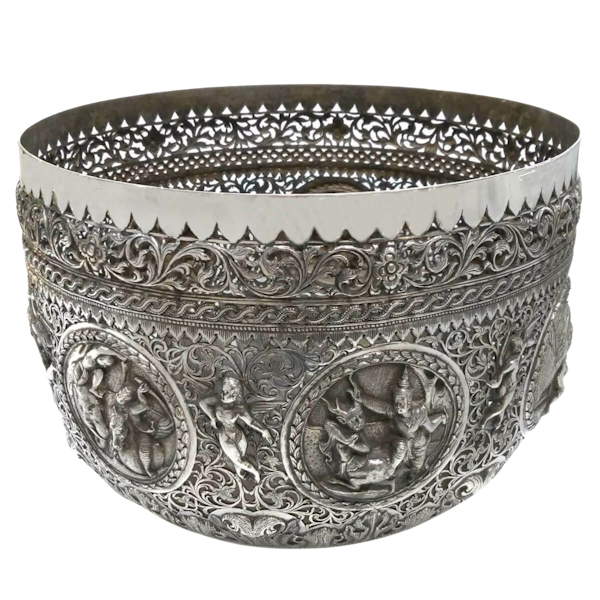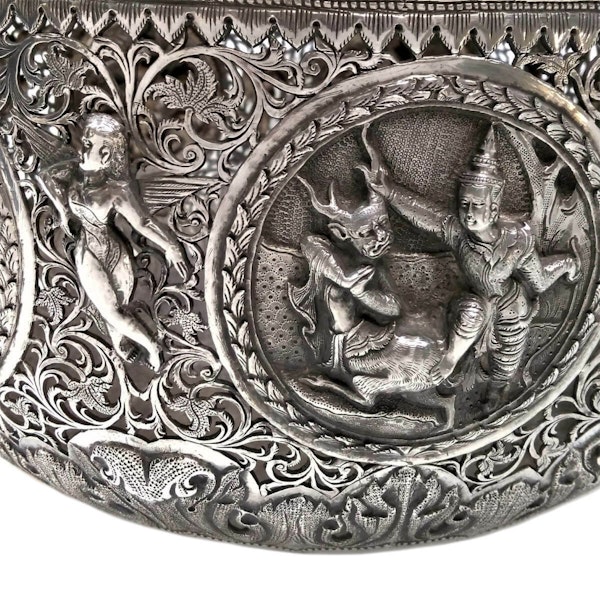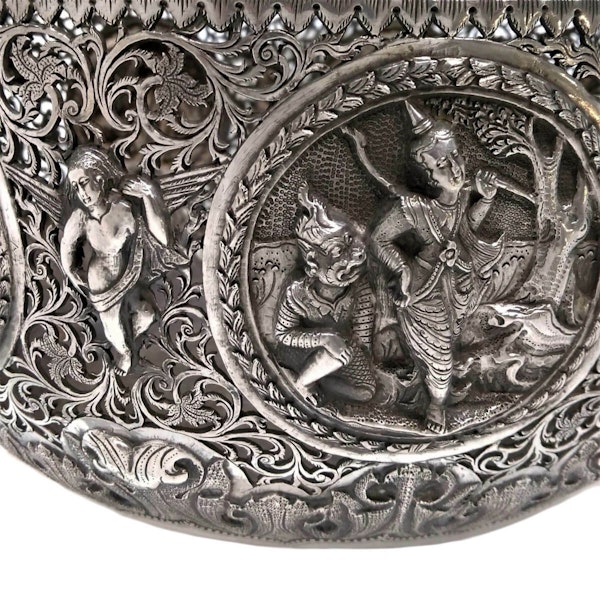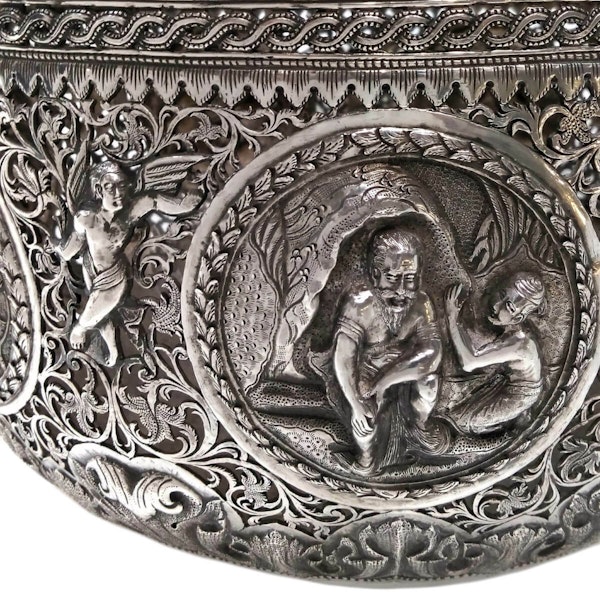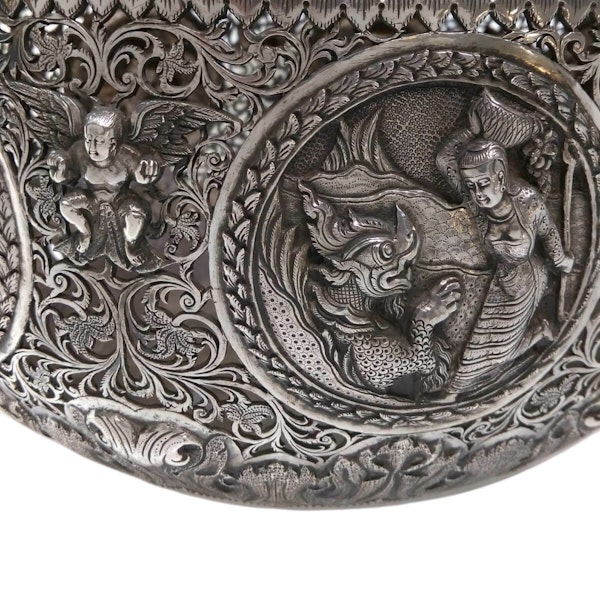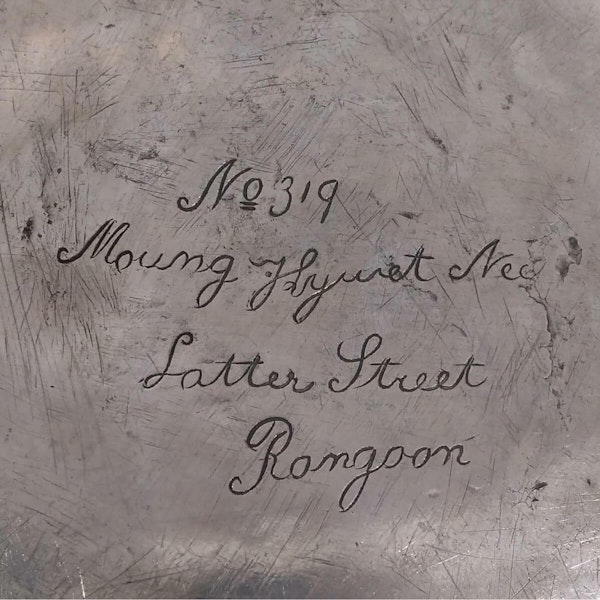Antique Burmese Silver Pierced Bowl, Maung Hywet Nee - Late 19th C.
Antique Burmese Silver Pierced Bowl, Maung Hywet Nee - Late 19th C.
£12,000.00
Description
This large Burmese silver bowl is of the highest quality and was probably made especially for an exhibition. Most unusually, it is numbered. It has also been signed to the underside of the base in English, rather than Burmese script. At this time, many silversmiths were illiterate and signed their work with a unique pictorial mark rather than script but Maung Hywet Nee (also translated as Maung Kywet Ni or Maung Chwet Nee) signed his work in writing and we have sold examples of his work, signed in Burmese script, previously. The number and the use of English indicate that the bowl was probably made for an International exhibition rather than a Burmese event. Maung Hywet Nee was a master silversmith who is recorded as working in Moulmein before moving to Rangoon, who is known to have exhibited at local and international exhibitions. This bowl may have been exhibited at the Burma Court of The Colonial and Indian Exhibition, held in South Kensington, London, from 4 May to 20 November 1886. The catalogue states “A fine collection of gold and silver ware from Rangoon, and also from the Shan States, exemplifies the well-known and highly-esteemed silver-work of Burma.” These exhibitions sought to showcase the ‘best of the best’ in every field in order to maximise prestige and to stimulate trade. The inscription to the underside of the bowl states:-
No 319
Maung Hywet Nee
Latter Street
Rangoon
An old street map of Rangoon shows that Latter Street ran north from the river towards Canal Street. It was situated in the heart of Rangoon’s commercial district and close to some of the international clubs and meeting places popular with the international community living or trading there.
This bowl has been ornamented with great artistry and incredible skill. The design has been well planned and the execution is precise, the silver has been fashioned with the greatest care. We are amazed at how crisp, sharp and fresh the work still is, unblemished, the condition is still as perfect as the day the bowl was made. The ornament has been crafted using repousse, chasing and hand piercing techniques. The principal border features seven Renaissance inspired tondos - roundels with figural scenes - which are framed by paddy wreaths. These alternate with a depiction of a single celestial or angelic winged figure. The tondos and figures are suspended within the most delicate tracery of hand cut and chased silver which forms an intricately patterned backdrop of long curling tendrils and small leaves. The top of the principal border echoes the shape of the rim above and each scallop has been chased with a series of closely packed vertical lines, providing textural interest.
The tondos and the angelic winged figures depicted between them have been influenced by the Eastern and Western artistic traditions. Angels can be found in the Christian, Islamic and Jewish holy books and feature in their religious art. They are usually perceived as benevolent celestial beings who act as messengers between God, or Heaven, and Humanity. Celestial nymphs are also found in the Buddhist tradition. One story tells of Buddha taking his brother, Nanda, on a journey to heaven where they encounter beautiful celestial nymphs. The figures depicted on the bowl all have wings and each figure has been depicted in a different pose. Some of these figures are male and others female but their features are all distinctly Burmese. The poses of some of the figures and the modest way in which some of their naked bodies have been covered, shows the influence of European Renaissance art.
The seven scenes depicted in the tondos are:-
A fight between a poorly dressed man on an elephant wielding a knife and a finely dressed man on horseback who is brandishing a sword; A woman walking in the countryside and carrying a basket of fruit on her head encounters a chinthe who has been watching her approach; A king holding a weapon with his left hand as he also holds the antler of a mythical creature resembling a satyr, who he is pinning down. The composite creature has a human torso and is clothed to the waist, whilst the lower part of his body is that of a deer. The creature has his hands together as if pleading for mercy; A poor man is visiting a bearded and poorly dressed hermit who is living in a cave; The king is sitting with his consorts or perhaps his family whilst another older man (possibly a high ranking courtier or visiting king) is hidden from view behind the throne. The king's arm is placed around the shoulders of one of the women in a protective gesture; A king is standing near a tree, he holds a dagger in his left hand, as if ready to stab. There is a mythical creature called a belu behind him who is watching. In Burmese folklore, belus were ogres, man-eating humanoid beings capable of shifting shape. Some belus were malevolent and others benevolent, they appear in the Jataka tales and in the Yama Zatdaw, a Burmese version of the Ramayana. The final tondo depicts a seated king with three women. The king holds his drawn sword aloft in his right hand and has pinned a female down with his left. The lady to the right has crossed her arms and watches, the lady to the left, kneels demurely with her eyes averted.
Underneath the principal border and to the lowest part of the bowl is a plain silver border with a pronounced lotus petal edge finished with a beaded border. Above this, a bold vegetal border provides contrast through its strong lines and textured surface finish providing a matte ground. The tops of the outward curling leaf of the tallest leaves, have no texture and appear to be highlighted. These leaves alternate with a series of three smaller water cabbage leaves. Each leaf has been separated from its neighbours by a single large tear-shaped piercing between adjacent leaves.
To the top of the bowl, a plain silver border forms the rim, providing strength and rigidity to the whole structure and protecting the pierced panels below. The lower edge of the silver has been cut and scalloped. This plain border sits above a panel of elegant naturalistic scrolling foliage alternating with a four-petal flower, all in bas-relief. Below a two strand twist border with each ‘thread’ beaded to the outer edge. This panel has also been pierced. The beaded edge of the 'threads', echo in the narrow beaded border below.
This bowl is exceptional; an antique Burmese silver bowl of large size which is still in the same condition as when it was first purchased and shows no wear. Made in Rangoon in the late 19th century, it has been fully signed by the maker, Maung Hywet Nee, a master silversmith, known to have participated in International Exhibitions of the late nineteenth century. The design is of breathtaking complexity, an absolute tour de force, which has been flawlessly executed with supreme skill and must have taken hundreds of hours of painstaking labour to complete. Numbered to the underside, it is very likely that this bowl was exhibited at one of the great International Exhibitions of the era.
Provenance:- European art market
| item details | |
|---|---|
| Origin | Asian |
| Period | 19th Century |
| Style | Other |
| Condition | Excellent |
| Dimensions | Weight:1940 grams |
| Diameter | Height 23 cms; Width 30 cms |
Product REF: 10054
